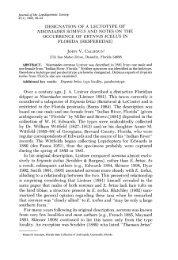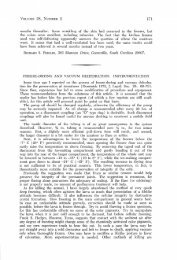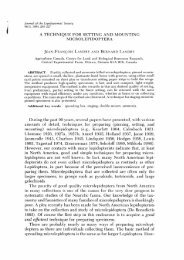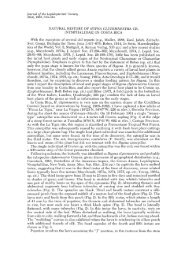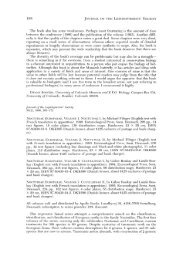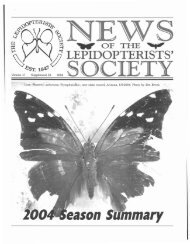Biology of Anaea ryphea - Yale University
Biology of Anaea ryphea - Yale University
Biology of Anaea ryphea - Yale University
You also want an ePaper? Increase the reach of your titles
YUMPU automatically turns print PDFs into web optimized ePapers that Google loves.
256 JOURNAL OF THE LEPIDOPTERISTS' SOCIETY<br />
Herbivory and Associated Fauna<br />
<strong>Anaea</strong> <strong>ryphea</strong> larvae seldom were seen eating the lowest leaves (old<br />
and damaged), and they never fed on apical leaves. Other herbivores<br />
also were observed on the intermediate portions <strong>of</strong> the plants. One<br />
species <strong>of</strong> cricket (Orthoptera: Gryllidae) ate patches from the leaves<br />
giving them the aspect <strong>of</strong> lace; one species <strong>of</strong> beetle (Coleoptera: Chrysomelidae)<br />
was observed eating the petiole; and one species <strong>of</strong> true bug<br />
(Hemiptera) appeared to be feeding on the petiole. Larvae <strong>of</strong> Hypna<br />
clytemnestra Cramer (Nymphalidae) are common on Croton fioribundus,<br />
frequently outcompeting A. <strong>ryphea</strong> with their ability to defoliate<br />
small plants. There also is a species <strong>of</strong> aphid (Homoptera: Aphidae)<br />
that uses C. fioYibundus. Individuals aggregate on the undersides <strong>of</strong><br />
leaves, and as a result, the upperside becomes dotted with white spots.<br />
A leaf-mining microlepidopteran was taken to the laboratory for<br />
rearing, but all individuals died before pupation; hence, identification<br />
was not possible. The mine follows the edge <strong>of</strong> the leaf and when that<br />
area is used, the larva turns toward the central part <strong>of</strong> the leaf following<br />
the central vein, never crossing it. Pheidole ants (Hymenoptera: Formicidae)<br />
wee seen predating upon eggs <strong>of</strong> A. <strong>ryphea</strong> (n = 10), but were<br />
never observed imteracting with the larvae.<br />
In addition to Ithose species mentioned above, a variety <strong>of</strong> other insects<br />
and spiders were seen regularly on C. fioribundus, but not feeding on<br />
it. Some individuals <strong>of</strong> C. fioribundus produce globs <strong>of</strong> a translucent<br />
gum, usually close to the apical leaves, that perhaps serve as a mechanical<br />
defense against some herbivores.<br />
The practice <strong>of</strong> leaving the midvein and secondary veins intact, as<br />
exhibited by A. <strong>ryphea</strong>, appears to represent a feeding strategy described<br />
for other species <strong>of</strong> Lepidoptera (Compton 1987), and differs<br />
from the strategy <strong>of</strong> those species that cut the mid vein to prevent toxins<br />
from getting to the portion <strong>of</strong> the leaf to be consumed. The former<br />
strategy allows tile larvae <strong>of</strong> A. <strong>ryphea</strong> to avoid contact with the latex<br />
that C. fioribundus produces, which suggests that they are incapable<br />
<strong>of</strong> detoxifying or storing high concentrations <strong>of</strong> this substance. Hypna<br />
clytemnestra and the leaf-mining microlepidoptera reported from C.<br />
fioribundus also avoid the midvein, although the former may eat secondary<br />
veins. Thiis type <strong>of</strong> behavior has been interpreted as an important<br />
step toward a disguise for these larvae (Hingston 1932) which add pieces<br />
<strong>of</strong> leaves and fecula to the midvein to improve the resemblance <strong>of</strong> the<br />
substrate to their body (Fig. 4) . Such a behavior may reduce the level<br />
<strong>of</strong> predation.





